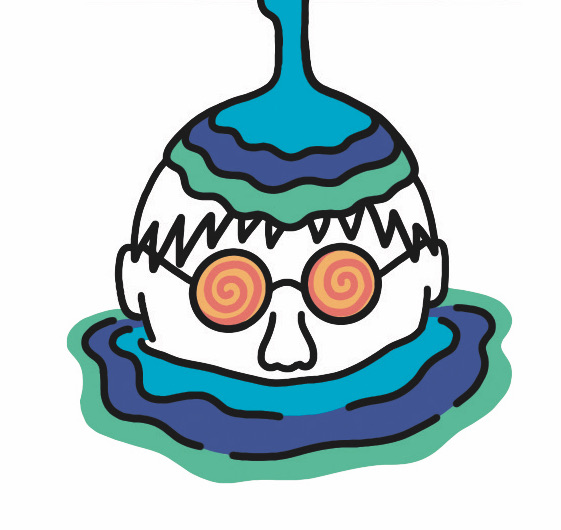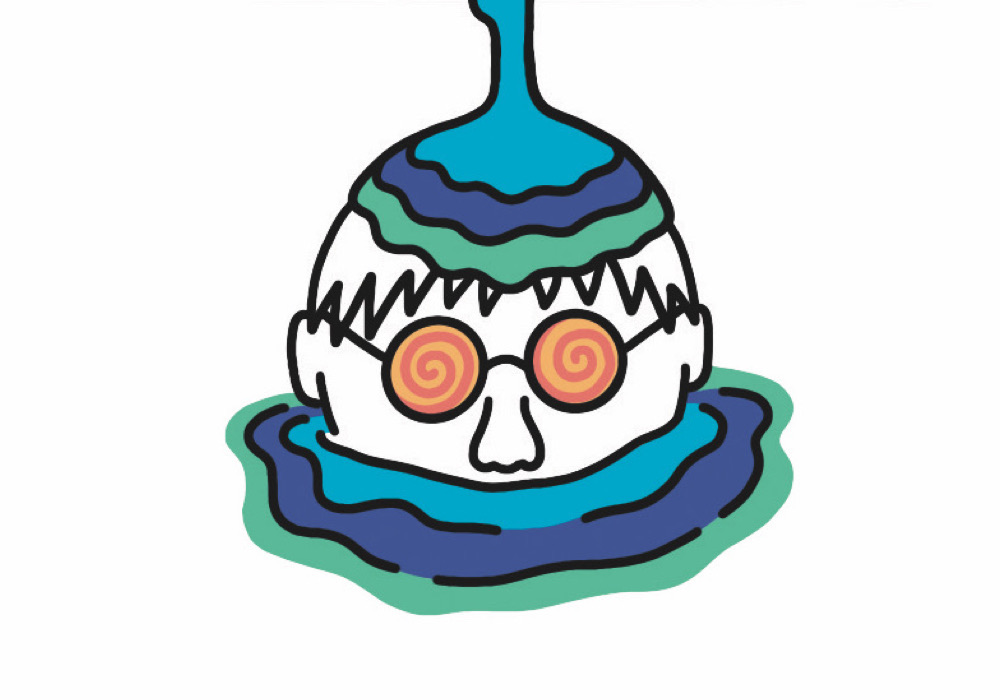
Psychedelics and Society Part 1: The NewMo Psychedelic Resource List
Written by Lydia Laurenson
Illustration by Stephen Lim
Published September 19, 2020
We are entering a new psychedelic Renaissance. Michael Pollan’s new pro-psychedelic book was featured on the front page of the New York Times Book Review; reputable magazines like the New Yorker are publishing accounts of staff writers’ personal drug use; the California Institute of Integral Studies is running ads on Bay Area public transit about their psychedelic therapy teaching program. This is the largest pro-psychedelic upswing America has seen since the 1960s.
But the cultural excitement isn’t being matched with well-distributed safety information, much less an understanding of the potential societal risks. The 1960s had a lot of great stuff going on, and also a lot of terrible fallout. Charles Manson’s murderous cult, for example, was a group of psychedelic-using hippies who became famous for killing seven people around Los Angeles. In San Francisco, there were tales of LSD-facilitated gang rapes and hippie mothers dosing their five-year-olds with acid, chronicled by writers like Joan Didion. California was ground zero for the first psychedelic revolution — and California was also the first state to declare LSD illegal, in 1966.
Psychedelics can be transformational, connective, awe-inspiring, awesome, and incredibly fun. They can also lead to psychotic breaks; can be used as tools to enable emotional, sexual, and physical assault; and are poorly understood even by many people who use them regularly.
America proved unable to integrate psychedelics positively into our society once before. How can we do better this time? What does a morally, emotionally, scientifically, and spiritually grounded drug-using culture look like? What are the dangers and opportunities of psychedelics, both on a personal level and a broader cultural level?
[[This article appears in Issue One of The New Modality. Buy your copy or subscribe here.]]
The Modern Context: Business and The New Psychedelic Renaissance
Erik Davis, a writer who has long specialized in consciousness culture, wrote a great article called “Capitalism on Psychedelics: The Mainstreaming of an Underground” back in 2018. You can find it on his website or at the website for the Chacruna Institute of Psychedelic Plant Medicines, where it was originally published. He points out that the “juggernaut of individualistic psychedelic pharmaceuticals” is “already in motion,” funded by private profit-seeking interests. He adds: “The ‘psychedelic community’ can no longer pretend that the process of mainstreaming is a purely positive development... separate from the larger crises of capitalism, militarism, authoritarianism, and the intensification of technological control over subjectivity.”
One recent casualty of these forces was Reality Sandwich, which was once an online community featuring perspectives from psychedelic literati. In 2019, RS suffered a hostile corporate takeover by new owners who seem intent on looting the brand for every penny now that psychedelics are cool again… even if that means killing it. The saga was chronicled on the drug policy website Psymposia by RS’s former managing editor, Faye Sakellaridis, who notes that “Reality Sandwich [originally] built its reputation by providing content from serious writers whose authority the reader could trust… Its intellectual integrity made it a trusted source.” Sakellaridis then sadly states that the new, rebranded RS is “irresponsible and misleading” and that it “oversimplifies the psychedelic experience in a way that is naive, which is potentially dangerous.”
We can’t save every newbie or grassroots community that gets distorted, or crushed, by the wave of psychedelic popularity. But we have options. I recently cried while reading “We Will Call It Pala: A Story for the Psychedelic Movement,” published on the website for the nonprofit Auryn Project. It’s a fiction story, set in the near future, about a woman who accepts the wrong kind of money to fund her psychedelic therapy clinic startup, and the depressing outcome. At the end, Auryn asks: “What vision do you hold in your heart for a psychedelic future? What will you do now, while you can, to see that it is realized?”
What, indeed?
At NewMo, we’re publishing high-quality stories and resources about psychedelic culture, written by people who know what they’re talking about. Are you one of those people? Submissions and ideas are welcome through our form at: bit.ly/HelpTheNewModality
You’ll find an example in the pages of our first print issue — check out “Hosting Safer Psychedelic House Parties” by Annie Oak. (Plus, we made a checklist for your parties! — click here to get our House Party Risk Reduction Checklist in thrilling downloadable PDF.)
In the meantime, here are some favorite psychedelic support organizations...
Resources For the Psychedelic Renaissance
- Erowid is an informational website that’s served the community for over two decades. It’s got everything from diagrams of drugs’ molecular structure, to personal experience reports. In 2015, the New Yorker published an in-depth profile of Erowid’s founders called “The Trip Planners,” which turned out better than I expected considering that it’s a relatively mainstream magazine.
- The Zendo Project supports community mental health, with expertise in psychedelics. They create pop-up tents at events like Burning Man, where they receive people experiencing psychedelic overwhelm (as well as mental health crises, and major spiritual experiences). We have an interview with one of the founders, Ryan Jay Beauregard, on the NewMo website.
- The Multidisciplinary Association of Psychedelic Studies (MAPS) was founded in 1986, and is at the forefront of psychedelic therapy. (They’re also the parent organization for the Zendo Project.) MAPS got their own 2015 New Yorker article, too: “The Trip Treatment” by writer Michael Pollan, who later published a nonfiction book about psychedelics called How To Change Your Mind.
- The Women’s Visionary Council (WVC) is a nonprofit organization for psychedelic women and their allies, founded in 2008. The WVC hosts the Women’s Visionary Congress and their website offers risk reduction and safety tips. The organization provides funding, gatherings, and support for women healers, researchers, activists, and artists who work with non-ordinary states of consciousness.
- Students for a Sensible Drug Policy is an international, grassroots, youth-led nonprofit that delivers “honest drug education” and holds a mission to end the War on Drugs.
- DanceSafe is a 20-year-old public health nonprofit focused on harm reduction in the nightlife community. Their site distributes information and drug testing kits.
Check out those resources if you need information or community support; they may be able to help you. And whatever you choose to do, good luck, and have a great time.
[[This article appears in Issue One of The New Modality. Buy your copy or subscribe here.]]
Transparency Notes
Lydia Laurenson is the editor in chief of The New Modality. Stephen Lim is an illustrator, animator, and tattoo artist living and working in Brooklyn, NY; find him at wonkycube.com. This article was lightly fact-checked by the NewMo editorial team.
There's more about our transparency process at our page about truth and transparency at The New Modality.

